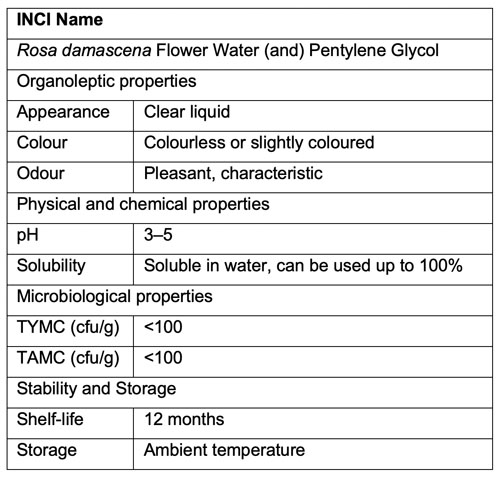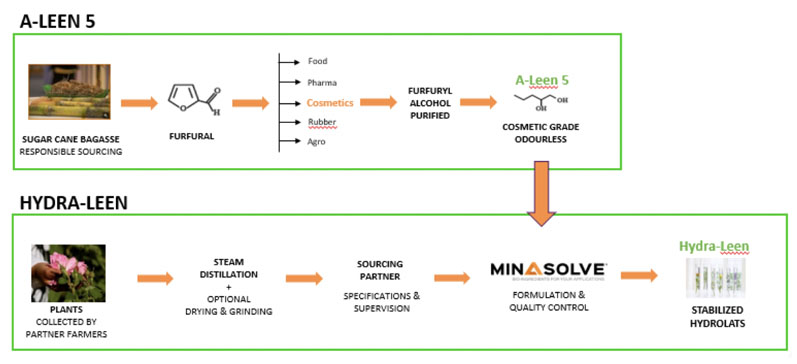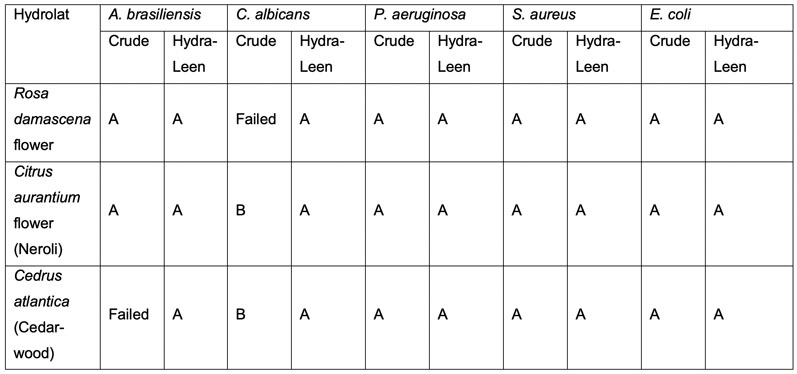The distillation of hydrolats or flower waters goes back centuries. The technique of steam distillation was used at the beginning of the golden age of Arabian culture, for example, in the 8th century.
The hydrolat is the evaporation water that is produced during the steam distillation of an aromatic plant or flower. At the end of the distillation, it separates from the essential oil and is now loaded with steam-volatile aromatic molecules (Figure 1).
Flower waters are attractive and cost-effective perfuming ingredients, especially for natural cosmetics. They can be either applied directly to the skin as a refreshing spray, for instance, or can be used as perfuming additives in personal care formulations.
As aqueous herbal distillates contain lower concentrations of aromatic substances than essential oils, they are comparatively easier to dose and safer to use. The application of hydrolats in industrially manufactured cosmetics still faces several hurdles. The main obstacle being that hydrolats are inherently unstable and that their supply is tied to fixed harvest periods.
This article showcases how the combination of biobased 1,2-alkanediols with five to eight carbon atoms with natural hydrolats stabilises the floral waters, which extends their shelf-life long after harvesting. It is a major improvement compared with traditional applications and facilitates both storage and logistic schemes.

Figure 2: The Hydra-Leen range of stabilised hydrolats
Because hydrolats are mainly water-based and are produced in artisanal facilities, often next to the fields in which they’re grown, they are non-sterile and susceptible to microbial infection. This induces a significant health risk to consumers. In addition, microbes can also change the overall composition of a hydrolat, which can ultimately lead to a deterioration in odour.
In any case, microbial contamination shortens the shelf-life of hydrolats. It also represents a considerable economic risk, especially when the perfumed water has to be transported for long distances or through tropical regions. Hydrolats are therefore often stored in a cool place or preserved to maintain their original freshness.
However, cold storage may result in limited physical stability of the hydrolats. The lipophilic aroma components contained in hydrolats can form a small oil phase upon freezing/thawing or under cold conditions.
Composition and technical specifications
These well-known stability problems linked to hydrolats were recently solved in a novel way by adding biobased 1,2-alkanediols with five to eight carbon atoms to the natural hydrolats. A range of hydrolats stabilised with this green technology is now part of Minasolve’s product portfolio and distributed in Italy by Active Up, under the brand name Hydra-Leen (Figure 2).
The technical characteristics of Hydra-Leen 5 Rose can be found in Table I.

Table I: Technical specifications of Hydra-Leen 5 Rose
1,2-Alkanediols are frequently used cosmetic ingredients with skin moisturising, emollient and dissolving properties. Furthermore, they are known to create self-preserving formulations that do not support the growth of micro-organisms.
Concentrations of alkanediols lower than 5% solved two technical problems in one: the growth of micro-organisms was effectively prevented at concentrations below the minimum inhibitory concentration of the diol. Moreover, the uniform composition of the hydrolats were maintained owing to the stabilisation of their lipophilic components in aqueous solution.
The accordingly stabilised hydrolats are COSMOS-approved and compliant with NATRUE guidelines, which enables their application in ecocertified cosmetics.
An example of the overall manufacturing process is summarised in Figure 3. The stabiliser, in this case biobased pentylene glycol (A-Leen 5), is manufactured from sugarcane bagasse according to the principles of green chemistry. Full traceability is ensured thanks to a direct collaboration with the producers of the vegetable raw materials, thereby meeting the growing demand for transparent supply chains.

Figure 3: Production process of stabilised hydrolats (Hydra-Leen)
Efficacy
The stabilising effect of alkanediols on different hydrolats was tested by microbial challenge tests according to ISO 11930 on crude hydrolats and the corresponding Hydra-Leen counterparts (Table II). It was found that most hydrolats are partially self-preserved against bacterial contamination whereas yeasts and moulds pose a significant risk of contamination.

Table II: Microbial stabilisation of hydrolats with 1–3% of pentylene glycol, results of challenge tests according to ISO 11930
The Hydra-Leen range met criteria A of the Challenge Test and therefore contains less than 100 cfu/g of bacteria, yeasts and moulds.
Owing to their increased stability, these hydrolats can be stored for a longer period of time, which enables their transport and makes them available during the whole year. As a result, formulators can create products with homogenous characteristics and consistent quality.
Safety
Skin compatibility and sensitisation tests have been performed; the HRIPT skin allergy test gave a negative result: repeated applications of the Hydra-Leen 5 Rose under an occlusive patch (nine consecutive applications within 30 days, Finn Chamber, 20 μL per patch) on a panel of 50 subjects induced no irritation and no allergic reaction on the skin. In conclusion, Hydra-Leen 5 Rose shows excellent skin compatibility.
Application and use
Hydra-Leen 5 Rose represents an ideal solution to perfume natural cosmetic formulations. It can be used in all type of formulations (even up to 100%) and is adapted to all skin types. Hydra-Leen 5 Rose has the following properties: antioxidant and toning, refreshes and soothes skin prone to redness, and delivers a powerful and fresh scent that brings the sweet smell of rose to your formulation.1
Reference
1. X. Fernandez, C. André and A. Casale, Hydrolats et Eaux Florales, Vertus et Applications (Vuibert, Paris, France, 2014).
